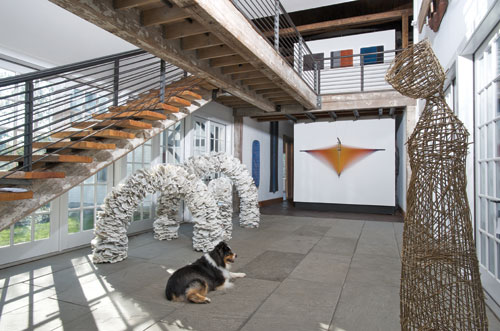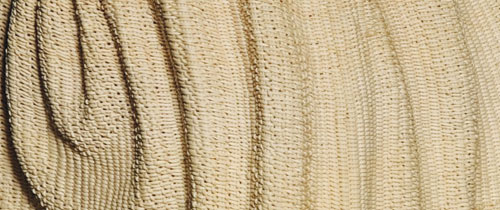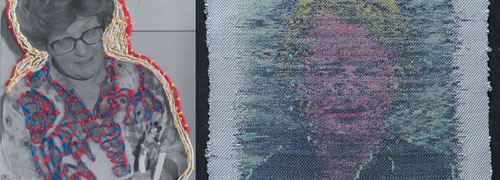
We attended the opening of Knitted, Knotted, Netted at the Hunterdon Museum of Art in Clinton, New Jersey last week. The Museum is a picturesque venue, presenting changing exhibitions of contemporary art and design in a 19th century stone mill that is on the National Register of Historic Places. The town of Clinton offers speciality shops featuring antiques, quilts, country furnishings and, intriguingly in one case, “Things We Like.”

Norma Minkowitz, Kazue Honma, Noriko Tanikawa, Hisako Sekijima
Knitted, Knotted, Netted includes work by 12 artists. The techniques highlighted in Knitted, Knotted, Netted have ancient lineages and have seen a resurgence through their use by contemporary artists. Each of these methods involves the looping of a thread or cord, differentiating them from braiding and weaving, in which elements may interlace but not necessarily loop through each other. The artists in this exhibit employ the techniques of the title in diverse ways and in widely differing materials, varied in size, shape and color. The two- and three-dimensional artworks in the exhibit use not only plant and animal materials but also industrial and synthetic materials, creating looped structures never envisioned in earlier contexts. The highlights for us: the work by the four artists represented by browngrotta arts, of course — three strong works by Norma Minkowitz and a work of edgeworthia bark by Hisako Sekijima, grouped with works by two of her students, Kazue Honma and Noriko Takamiya — and also, The Crowded Planet series by Carol Westfall. Westfall says that the series is composed of hundreds of tiny “men,” the stick figures we drew as children. “If you take the top two arms and pull them together you create the kanji character for man, nin or jin or hito,” she explains. “I compress all these tiny ‘men’ together and form the ball which is This Crowded Planet.”

Carol Westfall’s The Crowded Planet Series
The exhibit, at 7 Lower Center Street, Clinton, NJ, 908-735-8415, continues through January 24, 2010.





 The opening of the 10th Wave III at Artifact Design Group, 2 Hollyhock Lane, Wilton Connecticut is from 3:30 to 7:30 this Friday the 9th of October. The exhibition features work from more than 40 artists from Europe, Asia, Canada, the US and the UK. Also featured in the exhibition are new furniture designs by Gregory Clark. The show will run through November 28, 2009. Hope you’ll get a chance to stop by!
The opening of the 10th Wave III at Artifact Design Group, 2 Hollyhock Lane, Wilton Connecticut is from 3:30 to 7:30 this Friday the 9th of October. The exhibition features work from more than 40 artists from Europe, Asia, Canada, the US and the UK. Also featured in the exhibition are new furniture designs by Gregory Clark. The show will run through November 28, 2009. Hope you’ll get a chance to stop by!


Sneak Peek 10th Wave III Catalog: Essay by Akiko Busch
Writer Akiko Busch has drafted an essay for the catalog 10th Wave III: Art Textiles and Fiber Sculpture, which is being printed this week. Busch is the author of The Uncommon Life of Common Objects (Metropolis Books), Geography of Home: Writings on Where We Live (Princeton Architectural Press) and, most recently, Nine Ways to Cross a River: Midstream Reflections on Swimming and Getting There from Here (Bloomsbury). A former writer for Metropolis Magazine, Busch writes about culture and design for a variety of publications. She is a regular contributor to the Considerings column in American Craft Magazine. About the work in the 10th Wave III, Busch writes,
The 164-page color catalogs can be ordered from http://www.browngrotta.com/Pages/catalog.34.html beginning October 30, 2009.